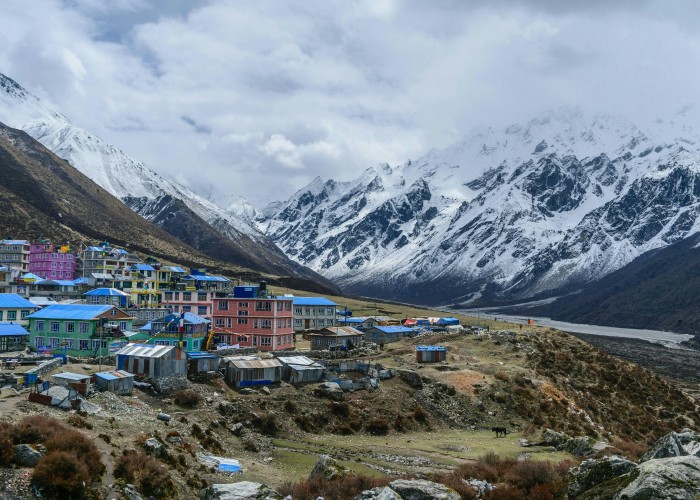The Goechala Trek is one of the most spectacular high-altitude treks in the Indian Himalayas, located in the northeastern state of Sikkim. Famous for its close-up views of the majestic Kanchenjunga, the third-highest mountain in the world, this trek offers a rare chance to walk amidst rhododendron forests, alpine meadows, and rugged mountain passes. Goechala Trek (Sikkim).
What makes this trek unique is the dramatic sunrise view from Viewpoint 1 near Goechala Pass, where the peaks of Kanchenjunga, Pandim, and Kabru glow golden with the morning light. Trekkers from across the world often call it one of the most rewarding Himalayan treks.
- Region: West Sikkim, India
- Starting Point: Yuksom
- Highest Altitude: Around 15,100 ft (4,600 m)
- Difficulty Level: Moderate to challenging
- Famous For: Panoramic views of Kanchenjunga and other Himalayan giants
Best Time to Visit
The best seasons for the Goechala Trek are spring (April to June) and autumn (September to November).
- April–June: Rhododendrons bloom across the forests, making the trail vibrant with colors. Clear skies enhance mountain views.
- September–November: The post-monsoon season offers crystal-clear visibility and a crisp chill in the air. Autumn sunsets and sunrises are particularly stunning.
- December–March: The trek is usually closed due to heavy snow and harsh weather conditions.
How to Reach
The trek begins from Yuksom, a small town in West Sikkim. Here’s how to reach:
By Air
- The nearest airport is Bagdogra Airport in West Bengal, about 160 km from Yuksom.
- From Bagdogra, taxis and shared jeeps are available to Yuksom via Jorethang or Pelling.
By Train
- The closest major railway station is New Jalpaiguri (NJP), about 150 km from Yuksom.
- From NJP, shared jeeps, buses, or private taxis can take you to Yuksom.
By Road
- Yuksom is well connected by road to Siliguri, Darjeeling, and Gangtok.
- The drive from NJP or Bagdogra to Yuksom usually takes 7–8 hours.
Entry Fees and Permits
Trekkers need multiple permits for the Goechala Trek.
- Inner Line Permit (ILP): Required for all foreign nationals to enter Sikkim. Available in Rangpo and other checkpoints.
- Trekking Permit: Issued by the Sikkim Tourism Department.
- Kanchenjunga National Park Entry Fee: Approx. INR 200–500 per person (subject to change).
- Always carry multiple photocopies of ID proof and passport-size photographs.
Food Availability and Meal Options
Food on the Goechala Trek depends on whether you trek independently or through an organized group.
- Organized treks: Meals are usually arranged, including vegetarian food like rice, dal, vegetables, noodles, soups, and tea.
- Independent trekkers: You can find small shops and homestays in villages like Sachen and Tshoka. Beyond that, carry dry food, instant noodles, and energy bars.
- Water: Streams are available along the route. It is best to carry purification tablets or a portable filter. Goechala Trek (Sikkim)
Packing List and Essentials
Clothing
- Trekking shoes with ankle support
- Thermal inner layers for cold nights
- Quick-dry pants and T-shirts
- Fleece jacket and down jacket
- Raincoat or poncho
- Woolen gloves, cap, and sunglasses
Gear
- Backpack (50–60 liters) with rain cover
- Trekking poles
- Sleeping bag (for sub-zero temperatures)
- Headlamp with spare batteries
Other Essentials
- Sunscreen and lip balm
- First aid kit with altitude medicine
- Water bottle or hydration system
- Dry fruits, chocolates, and energy bars
- Biodegradable toiletries
Safety Tips and Local Regulations
- Trek only with permits and registered guides.
- Avoid plastic waste; carry back all non-biodegradable items.
- Weather changes quickly; keep warm and waterproof clothing ready.
- Acclimatize properly to avoid altitude sickness.
- Carry cash as ATMs are not available in remote areas.
- Respect local wildlife and stay on designated trails.
Tips for Beginners and First-Time Visitors
- Start fitness training at least a month before the trek. Jogging, cycling, and stair climbing help improve stamina.
- Take acclimatization breaks, especially at Tshoka and Dzongri.
- Stay hydrated and avoid alcohol during the trek.
- Carry light luggage and pack only essentials.
- Hire a local guide if you are trekking for the first time in high altitudes.
Local Customs and Cultural Etiquette
Sikkim is known for its Buddhist culture and warm hospitality. While trekking, respect local traditions.
- Dress modestly, especially in villages and monasteries.
- Remove shoes before entering monasteries.
- Do not disturb prayer flags or religious artifacts.
- Greet locals with a polite “Namaste” or “Tashi Delek.”
FAQ Section
1. How long is the Goechala Trek?
The trek typically takes 8–10 days, depending on the itinerary.
2. What is the highest altitude?
The trek reaches around 15,100 ft (4,600 m) near Goechala Pass.
3. What is the difficulty level?
It is a moderate to difficult trek, suitable for trekkers with good fitness levels. Goechala Trek (Sikkim)
4. What is the best season for Goechala?
Spring (April–June) and autumn (September–November) are the best.
5. Are restrooms available?
Basic toilets are available at campsites. Some may have dry pits or tented toilets.
6. Can beginners attempt this trek?
Yes, with proper preparation and guidance. However, some experience in trekking is helpful.
7. Is camping allowed inside Kanchenjunga National Park?
Yes, designated campsites are available, but follow park regulations.
8. How cold does it get?
Temperatures can drop to -5°C to -10°C at higher campsites, especially at Dzongri and Lamuney.
9. Do I need to carry oxygen cylinders?
Not necessary for most trekkers, but carry altitude sickness medication. Guides usually carry basic first aid.
10. Are foreign nationals allowed?
Yes, but they require an Inner Line Permit (ILP) and must trek with a registered guide.
Conclusion
The Goechala Trek in Sikkim is a dream for trekkers who want to experience the grandeur of the Himalayas up close. With views of Kanchenjunga, pristine alpine forests, and high-altitude campsites, this trek blends natural beauty with cultural richness. Goechala Trek (Sikkim)






Leave a Reply